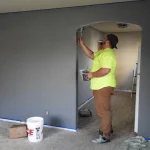As you enter your 60s, transitioning into a more comfortable and efficient living space becomes increasingly important. Whether you’re looking to downsize, make your home more accessible, or boost your financial security, it’s essential to consider how your home can work for you in this new chapter of life.
This article offers a guide on how to make your home serve you better after the age of 62. From financial options like reverse mortgages to practical home modifications, we’ll explore several ways to improve your living situation and well-being.
Evaluate Your Home’s Current Suitability
Before making big decisions, take a step back and assess how well your current home meets your needs. As you get older, mobility and accessibility become crucial factors in determining whether your home is truly working for you. Consider the following:
Mobility and Accessibility
Can you move around your home easily? Is it safe for you to navigate, especially if your health changes or if you develop mobility issues? Look at stairs, doorways, hallways, and bathrooms. Are they wide enough? Are there steps that could become obstacles?
Space Considerations
Do you have extra space that’s no longer necessary? Empty rooms may become a burden to maintain, and they can add to your overall expenses. Conversely, downsizing could help reduce upkeep and utility costs, simplifying life.
Home Maintenance
As homes age, they require more upkeep. Maintenance can become more of a hassle, from roof repairs to plumbing issues. Assess if your home needs significant repairs or is becoming costly to maintain. An easy-to-maintain home can significantly improve your quality of life.
Downsizing: A Practical Option
Downsizing is an increasingly popular option for those over 62. A smaller home can offer more convenience, lower costs, and less maintenance. But downsizing isn’t just about the house size—it’s about finding the right type of home for your needs. Here’s what you should consider:
The Right Location
Whether you move to a smaller home in the same area or relocate entirely, consider the location. Are you close to family, friends, medical services, or public transportation? Proximity to essential services can make a big difference in your day-to-day life.
Financial Considerations
When downsizing, you’ll likely sell your current home and buy something smaller. While this can relieve you of high maintenance costs, it’s important to evaluate whether the sale of your home provides enough funds for a new purchase. After you’ve sold your home, you might have extra money to invest or save.
Alternatively, you may take out a reverse mortgage to access your home’s equity without selling it. This option can provide financial flexibility, especially if you need additional funds for living expenses or home improvements.
Making Your Home More Accessible
A few simple modifications can make your home safer and more comfortable as you age. It’s important to focus on areas that will reduce risks and improve ease of use.
Bathroom Accessibility
The bathroom is one of the most common places where accidents occur. If you haven’t already, consider installing grab bars near the toilet and in the shower or bathtub. A walk-in shower with a non-slip floor is an excellent upgrade for easier access. Raised toilet seats can also improve comfort and ease of use.
Kitchen Modifications
Kitchens can also be tricky to navigate as you age, especially if you have trouble standing for long periods or bending down. Opt for pull-out shelves, adjustable height counters, or a lower oven. The goal is to reduce the strain involved in everyday tasks like cooking or cleaning.
Lighting and Visibility
Good lighting is essential. Your eyesight may change as you age, and adequate lighting can help prevent accidents. Consider brighter bulbs and motion-sensor lights, especially in hallways, stairways, and bathrooms.
Stairs and Hallways
Consider installing stair lifts or even a home elevator if necessary for homes with stairs. Also, ensure that hallways are well-lit and clutter-free to reduce the risk of falls.
Reverse Mortgages: A Financial Tool for Seniors
As you approach your later years, financial security becomes a top priority. A reverse mortgage is one option to help make your home work for you. A reverse mortgage allows homeowners aged 62 or older to convert part of their home equity into cash. This type of loan doesn’t require monthly payments; instead, the loan is repaid when you sell the home or pass away.
This financial product can be especially helpful if you want to stay in your home but need extra funds for living expenses, healthcare, or home renovations. However, it’s crucial to fully understand the terms, fees, and long-term effects before proceeding with a reverse mortgage.
Pros of a Reverse Mortgage
- No Monthly Payments: You don’t need to make monthly payments, which can ease financial pressure.
- Access to Cash: The funds from a reverse mortgage can help with bills, medical costs, or necessary home improvements.
- Stay in Your Home: You can remain in your home for as long as you live there and meet the loan terms.
Cons of a Reverse Mortgage
- Impact on Inheritance: A reverse mortgage reduces the inheritance left for your heirs, as the loan is repaid through the sale of the home.
- Fees and Interest: Reverse mortgages can carry high fees and interest rates that accumulate over time.
- Eligibility Requirements: To qualify, you must meet certain requirements, including age restrictions, home equity minimums, and a stable financial standing.
Before considering this option, consult a financial advisor to ensure a reverse mortgage is the right choice for your specific situation.
Aging in Place: Stay in Your Home for Longer
Aging in place refers to staying in one’s home as one ages rather than moving into a retirement community or assisted living facility. Many seniors prefer this option because it allows them to remain independent and in familiar surroundings.
How to Prepare Your Home for Aging in Place
To make aging in place a viable option, you need to adapt your home to fit your changing needs. In addition to the modifications mentioned earlier, consider:
- Installing a medical alert system or emergency response device
- Creating a network of support, such as neighbors, family, or caregivers
- Simplifying tasks like home cleaning and laundry, possibly by hiring services to assist
- Considering the use of technology for monitoring health or assisting with daily activities
The more you adapt your environment to your needs, the more independent and comfortable you’ll be.
Consider Renting or Shared Housing
Another option to consider is moving into a senior living community. These communities are designed specifically to meet the needs of older adults, offering various levels of care depending on your needs. Many senior living communities offer independent living options, where you can enjoy a private apartment while having access to shared amenities like meals, transportation, and social activities.
For those who require more assistance, there are also options for assisted living and memory care. These communities provide a sense of security, socialization, and peace of mind, making them a viable option for seniors who want to live in a supportive environment while still maintaining a degree of independence.
Conclusion
Making your homework for you after 62 is about more than just maintaining your property. It’s about creating a space that supports your health, comfort, and financial stability. Whether you stay in your current home with modifications or explore options like downsizing or reverse mortgages, the key is to make informed decisions that align with your needs and lifestyle. The goal is to ensure that your living situation enhances your well-being, providing both physical and financial security as you age.







